The electric guitar may be the most important and popular instrument of
the last half-century in American music. Certainly its introduction brought a major change
to American musical technology and has shaped the sound and direction of modern musical
styles.
![]()
The idea of using electricity to create louder string instruments already existed by the end of the 19th century. But it was only during the 1920s and 1930s that engineers, makers, and musicians began to solve some of the challenges of electronic amplification.
During the early years of its existence, the electric guitar's viability as a "true" instrument was frequently debated. The instrument's detractors often claimed it did not produce a pure, "authentic" musical sound. Country and jazz musicians, most notably Charlie Christian, were among its first defenders, championing the electric guitar's louder sound and ability to compete with other melody instruments in ensemble performances.

Country artist Noel Boggs
The development of the electric solid body guitar owes a great deal to the popularity of Hawaiian music in the 1920s and 1930s. Hawaiian guitars were solo instruments played with a metal slide. Electric Hawaiian guitars were the first instruments that depended entirely on their sound being amplified electrically not just acoustically.
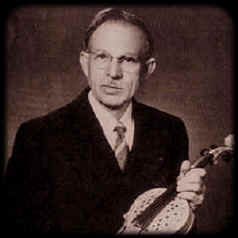
John Dopyera
John Dopyera of the National String Instrument Corporation took the idea of acoustic amplification to its limit, designing a steel-body guitar with banjo-type resonator-amplifiers built into the top.
|
|
A key figure was Adolph Rickenbacker who originally was to make metal components for Dopera Brothers' National Resonator Guitars. While at National, Rickenbacker met George Beauchamp and Paul Barth who had been working together on the principle of the electromagnetic pickup in which a current passed through a coil of wire wrapped around a magnet, creating a field which amplified the strings' vibrations. Together they formed the Electro String Company and in 1931 produced their first Hawaiian guitar a lap-steel known as the Frying Pan, the pickup made this guitar the first commercially viable electric. Their success prompted Gibson and others to start producing electric guitars.
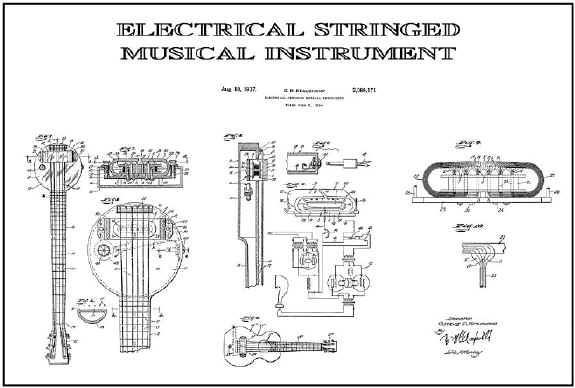
George Beauchamp's patent for the Rickenbacker Frying Pan was filed with the US Patent office in 1934 and issued in 1937.
By the late 1930s other makers and players adapted the new technology to the more traditional Spanish-style hollow-body wooden guitars, but were troubled with distortions, overtones, and feedback—the amplification of vibrations in the body of the instrument as well as in the strings. Inventors began trying to address these sound difficulties by experimenting with solid, rather than hollow, guitar bodies. The Slingerland company commercially introduced a Spanish solid-body electric guitar in 1939.
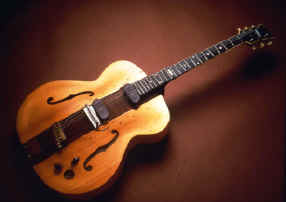
Gibson Log
Around 1940, Paul persuaded Epiphone to let him use workshop on Sundays, where in 1941 he built the historic "Log" guitar. Paul mounted strings and pickups on a solid block of pine to minimize body vibrations. During the 1940s, Paul Bigsby and Leo Fender also began experimenting with Spanish-style solid-body guitar design.
At the same time Les Paul was working in the same direction. Paul experimented with pick ups throughout the 1930s but had experienced feedback and resonance problems and began to think about a solid body guitar after hearing about a solid body violin by Thomas Edison. Paul was convinced the only way to avoid body feedback was to reduce pick up movement and the only way to do that was to mount it in a solid body.
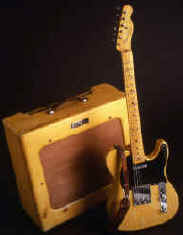
Fender Broadcaster aka Telecaster with amp
In the 1940s Gibson new electric models became firmly established. People began to work on ways of applying the solid body of the Hawaiian and steel guitars to regular instruments. In 1944, Leo Fender, who ran a radio repair shop, teamed up with Doc Kaufman, a former Rickenbacker employee, started K & F Company and produced a series of steel guitars and amplifiers. Fender felt the large pick-up magnets in use at the time need not be so large. He incorporated a new pick-up which he wanted to try out into a solid body guitar based on the shape Hawaiian but, with a regular properly fretted fingerboard. Though only meant to demonstrate the pick-up the guitar was soon in demand. 1946 saw the formation of Fender Electric Instrument Company and in January 1951 the introduction of the Broadcaster.
Ad in 1951 issue of Musical Merchandise for the Fender Broadcaster
On February 1951, Fender received a claiming Fender's use of Broadcaster on its electric guitar was an infrigement on the The Gretsch Manufacturing Company tragemark Broadcaster. The guitar was then renamed "Telecaster."
|
|
In 1947 Paul Bigsby in consultation with Merle Travis built a solid body electric guitar that shared certain design features with the Broadcaster that Fender introduced in 1948. Bigsby wasn't far from Fender operation in Fullerton and there is some question who was looking over whose shoulder
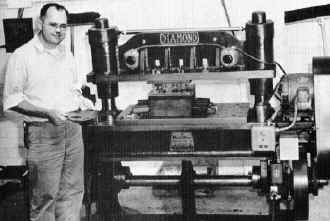
Leo Fender and Diamond punch press circa 1950
Photo Courtesy Richard R. Smith
Fender was more concerned with utility and practicality rather then looks and wanted a regular guitar with the clear sound of a electric Hawaiian but, without the feedback problems. The result was the the Broadcaster which he began producing in 1948 later renamed the Telecaster.
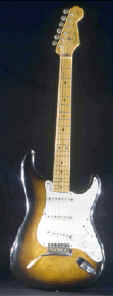
Fender Stratocaster
In 1954, Fender began producing the Stratocaster. Along with the Telecaster and the guitars Les Paul was designing for Gibson, they set the standard for solid body guitars.
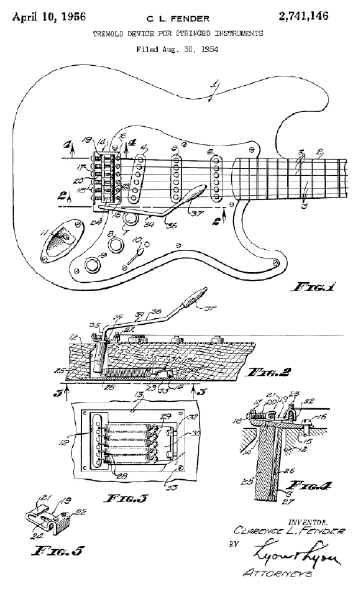
In 1955, Seth Lover, an engineer at Gibson, invented the humbucker pickup which revolutionized electric guitars - reducing the electrical hum from single coil pickups to nothing. These humbucker pickups first appeared on Gibson guitars and are widely used by many famous musicians.
Lemelson
Center - Guitar Exhibit at The Smithsonian Institute
Vintage Guitars